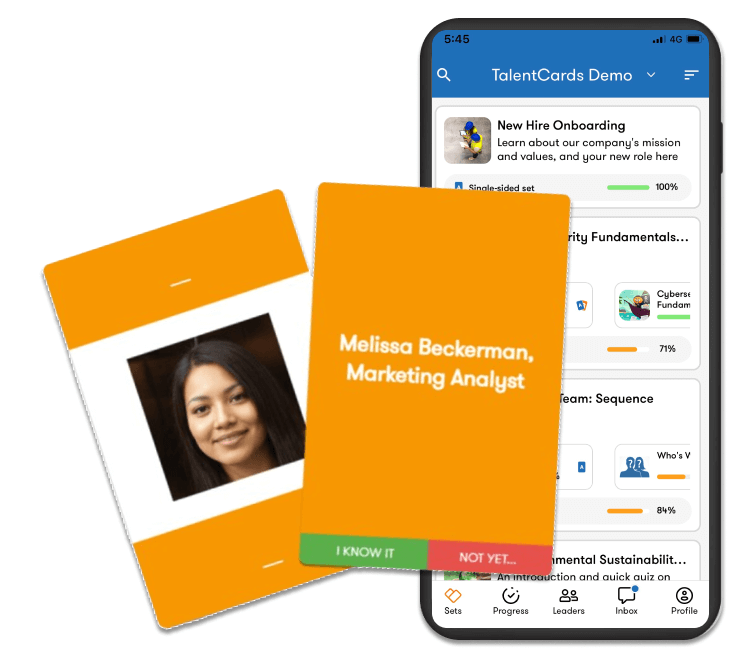According to a recent survey, 72% of companies have unfilled positions due to a lack of qualified workers. It’s natural that some roles require more previous experience than others, but regardless of the job requirements, everyone needs some amount of training to get on their feet. So when you do find the right (and qualified) person for the job, you have to ensure you onboard, develop, and retain them.
One way of doing this is having a highly effective new hire training program.
New employee training isn’t as simple as providing administrative information and a few training modules. For it to be effective, you must develop your new hire training program specific your company, the department your new hire will belong to, and their learning style Without a plan, you risk losing your greatest asset, your people.
In the same survey, onboarding managers were asked what cost their company would incur if a deskless employee were to quit one week after being fully onboarded.
Twenty-three percent of respondents stated the cost is over $5,000 per employee.
With that in mind, let’s explore one of the critical factors in employee retention— effective new hire training.
Understanding the significance of new hire training
Effective new hire training is a linchpin for the success of both employees and organizations. This strategic process goes beyond the basics, becoming a pivotal investment in the growth and sustainability of a workplace, especially with deskless workers.
Why new hire training is crucial
The initial days and weeks of employment set the tone for an individual’s tenure. Comprehensive new hire training ensures employees have the knowledge and skills to perform their roles effectively.
Engaged employees are more likely to be productive and satisfied in their roles. Organizations can instill a sense of belonging and purpose through well-designed training programs, enhancing overall employee engagement.
Impact on employee performance, engagement, and retention
When employees feel confident in their abilities, performance naturally improves. New hire training establishes a foundation for success, reducing the learning curve and enabling employees to contribute meaningfully to their teams.
Engaged employees are emotionally invested in their work. Training that emphasizes the organization’s values, goals, and expectations creates a sense of purpose, leading to higher levels of engagement among new hires.
Employees who receive thorough training and feel supported and are more likely to stay with an organization. A positive onboarding experience contributes to employee satisfaction and, consequently, higher retention rates.
New employee training needs to go beyond a must-do event. It must be a strategic part of your employee development and retention plan. Recognizing its significance is key to fostering a thriving workplace, particularly with your deskless workers.
Now that we’ve established why new hire training is so important, let’s move on to how you can create an effective training plan of your own.
How do I create a training plan for new hires?
1. Talk to current employees
In the quest for effective onboarding, current employees are invaluable resources. Their insights can provide a real-world perspective on what new hires truly need to succeed.
Conduct interviews or surveys to gather feedback on their onboarding experiences.
- What information was most beneficial?
- What aspects could be improved?
This employee-centric approach ensures that onboarding isn’t just a box to check but an employee-driven initiative.
2. Provide flexible and targeted training
One size doesn’t fit all, especially when it comes to onboarding.
Design a flexible training program, allowing personalized learning paths based on individual roles and responsibilities. Recognize the diverse skill sets and tailor training content accordingly.
A targeted approach ensures that new hires receive the specific knowledge and skills essential for their positions. Doing this improved initial engagement and, ultimately, retention.
3. Go beyond the basics
While administrative information is crucial, a truly effective onboarding process extends beyond the basics.
Yes, new hires need to know organizational policies and procedural details, but they also need a deeper understanding of the company’s culture, values, and long-term vision.
Incorporate elements that convey the essence of your organization’s identity, creating a holistic onboarding experience that nurtures a sense of belonging and purpose.
4. Target individual learning styles
People have diverse learning styles, and acknowledging and accommodating these differences is key to effective new hire training.
Some individuals thrive on visual content, while others prefer hands-on experiences. Recognize and integrate various learning methods, such as video tutorials, interactive workshops, or mentorship programs. An effective way to do this is by providing learning through a mobile training platform like TalentCards.
This approach ensures that new employee training with each new hire optimizes their understanding and retention of crucial information.
5. Involve your leaders
Leadership involvement in onboarding adds a powerful layer of connection and inspiration.
Incorporate sessions where organizational leaders share insights, anecdotes, and the company’s vision. This direct interaction fosters a sense of community and reinforces the idea that every employee plays a vital role in the overarching success of the organization.
Leadership presence also instills confidence and provides new hires with role models to guide their professional journey.
Effective new hire training goes beyond simple dissemination of information. It’s a dynamic process that involves current employees, caters to individual needs, goes beyond administrative details, and incorporates the wisdom and vision of organizational leaders.
By embracing these key components, organizations can cultivate a welcoming and empowering onboarding experience that sets the stage for long-term success and engagement.
What are the steps of the new hire training process?
New hire training typically involves several steps to ensure all of the necessary information, skills, and knowledge have been provided. This process can take days or sometimes weeks to complete. While it’s important to personalize your new hire training, here are the most common steps:
Step 1: Preboarding
Send a welcome email, directions for their first day, employment contracts, company policies, and essential documents to the new hire, initiating their engagement with your organization before day one.
Step 2: First day welcome
How you initially greet new hires on their first day significantly influences their perception of the company and impacts their productivity in the long run. A personal welcome from a senior staff member or hiring manager at the door sets a tone of care and support.
If they’ll be working in a physical location, offering a guided tour of the facilities and introducing team members fosters a sense of belonging right from the start of their journey with the organization.
Step 3: Make introductions
Your new staff will likely be interacting with many members of the organization. It’s important to make introductions immediately to both team members and management in and out of their department.
While theirs is a one-to-many experience, your current staff will likely remember them. Creating a collaborative environment starts on day one. Don’t neglect this important piece of your new hire training.
Step 4: Compliance training
Now that your new hire is off to a great start, it’s time to get into the nitty-gritty. Compliance training is up next. It’s important to ensure that e new employees are equipped with essential safety guidelines and procedures.
The best way to ensure all points are covered is through a customized training program on a mobile training platform.
Step 5: Job specific training
With compliance training complete, your new hire can move on to training specific to their new role.
This training might take place over several weeks, depending on the requirements of the role. Job specific training can focus on specific skills and products, soft skills, and cross-team relationships.
Remember that training isn’t a one-time event. Creating a culture of continuous learning will serve your staff and organization best.
Step 6: Gather feedback
Evaluation comes in two parts: assessing the new employee’s learning and evaluating the program as a whole.
Periodically assess employee understanding post-training by assigning assessments. This step ensures that the onboarding plan is effective, allowing for necessary adjustments to enhance its overall impact. Additionally, providing an onboarding survey to each new employee aids in continually improving your training program.
These steps collectively form a foundational framework for creating a thorough and successful new hire training process, setting the stage for the sustained success of individuals within your organization.
Creating a training schedule for new employees
Now that you’re clear on how to train a new employee, it’s time to think about the training schedule.
Day 1: Welcome and introductions
First day jitters are real. Help set the tone for your new hire by making this a day they can look back on and feel good about.
Week 1: General training
The first week should focus on the company. Policies and procedures are introduced during the orientation process. This involves learning about the company’s mission, values, policies, and compliance requirements. New hires also get introduced to the organizational structure and essential systems.
Weeks 2-4: Job specific training
Employees delve into role-specific tasks and responsibilities in the initial week of job-specific training at a new company.
This phase involves detailed guidance on job functions, specialized procedures, and hands-on training relevant to their positions. Employees receive instruction on using job-specific tools, software, or equipment necessary for their roles.
Additionally, they may engage in practical exercises, shadowing, or simulations to familiarize themselves with the specific tasks they’ll be undertaking.
Last day: Feedback
Gathering feedback is the last step that cannot be overlooked. This is your chance to gain insight into what went well and what needs improvement. Giving your new hire a chance to provide feedback allows you to refine the new hire training program and encourage open communication.
Help your new hires get to know your company and their team, right from their smartphones

FAQs
What is new hire training called?
Training new employees is called “new hire training” or “onboarding.” This training process is needed to successfully integrate new employees into the company and provide them with the necessary tools for growth and success.
What should new hire training include?
Creating a robust new hire training program involves several components to prepare employees for success. Be sure to include:
- Preboarding
- First day welcome and introductions
- Compliance training
- Job specific training
- Feedback
The key to elevating success
Recognizing the critical role of effective new hire training is critical in addressing the challenges of talent acquisition, retention, and overall organizational success. The initial days and weeks of employment significantly impact a new employee’s success rate. Engaging employees through well-designed programs boosts productivity and satisfaction and contributes to overall retention.
As organizations navigate the talent acquisition and retention landscape, effective new hire training emerges as a key strategy for success. Cultivating a welcoming and empowering onboarding experience sets the stage for long-term employee engagement and organizational accomplishments.
Key takeaways
- New hire training is a strategic initiative tailored to your company, department, and individual learning styles, ensuring a positive impact on employee retention and engagement.
- The involvement of organizational leaders in the onboarding process fosters connection, inspiration, and a sense of community to new staff.
- Prioritize flexibility in training schedules, allowing new hires to progress at their pace and focus on tasks rather than rigid time constraints, promoting personalized and effective learning paths.
- Regularly assess progress through check-ins, emphasizing task-oriented training and providing ongoing support. This approach contributes to sustained engagement, productivity, and overall success within the organization.


